 |
Search the Site with

|
USS Saratoga (CV 60)
- formerly CVA 60 -- decommissioned -
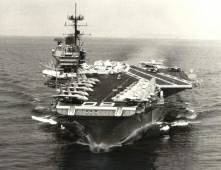 | 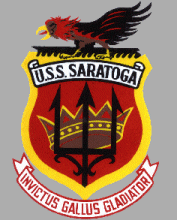 | 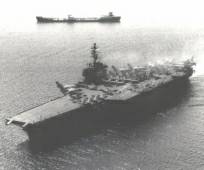 |
USS SARATOGA was the second ship in the FORRESTAL - class and the second "super - carrier" in the world. USS SARATOGA was the fifth ship in the Navy to bear the name. Commissioned as attack aircraft carrier CVA 60, the SARATOGA was redesignated as multi-purpose aircraft carrier CV 60 on June 30, 1972. Stricken from the Navy list on August 20, 1994, the SARATOGA was initially laid up at Philadelphia, PA., but was towed to Newport, RI., in 1998. During that time the carrier was on donation hold, however, on April 2, 2010, the Navy decided to scrap the SARATOGA. She spent the following years at Naval Station Newport awaiting her fate. In May 2014, the Navy announced that ESCO Marine of Brownsville, Tx, would scrap the SARATOGA for one cent. The carrier left Newport under tow on August 21, 2014, and arrived at Brownsville on September 15, 2014.
| General Characteristics: | Keel Laid: December 16, 1952 |
| Launched: October 8, 1955 | |
| Commissioned: April 14, 1956 | |
| Decommissioned: August 20, 1994 | |
| Builder: New York Naval Shipyard, Brooklyn, N.Y. | |
| Propulsion system: eight boilers | |
| Rudders: two | |
| Propellers: four | |
| Blades on each Propeller: five | |
| Aircraft elevators: four | |
| Catapults: four | |
| Arresting gear cables: four | |
| Length, overall: 1,063 feet (324 meters) | |
| Flight Deck Width: 250,3 feet (76.3 meters) | |
| Beam: 129 feet (39.3 meters) | |
| Draft: 37,7 feet (11.3 meters) | |
| Displacement: approx. 78,200 tons full load | |
| Speed: 30+ knots | |
| Planes: approx. 85 | |
| Crew: Ship: approx. 2,700 Air Wing: 2,480 | |
| Armament: three |
Crew List:
This section contains the names of sailors who served aboard USS SARATOGA. It is no official listing but contains the names of sailors who submitted their information.
- Click here to view the list.
- Click here
to see which USS SARATOGA memorabilia are currently for sale on ebay.
USS SARATOGA Cruise Books:
- Commissioning Cruise Book 1952-56
- Mediterranean Cruise Book 1958
- Mediterranean Cruise Book 1959-60
- Mediterranean Cruise Book 1960-61
- Mediterranean Cruise Book 1961-62
- Mediterranean Cruise Book 1963
- Mediterranean Cruise Book 1964-65
- Mediterranean Cruise Book 1966
- Mediterranean Cruise Book 1967
- Mediterranean Cruise Book 1969-70
- Mediterranean Cruise Book 1970
- Mediterranean Cruise Book 1971
- Vietnam Cruise Book 1972-73
- Mediterranean Cruise Book 1974-75
- Mediterranean Cruise Book 1976
- Mediterranean Cruise Book 1977
- Mediterranean Cruise Book 1978-79
- Mediterranean Cruise Book 1980
- Mediterranean Cruise Book 1984
- Mediterranean Cruise Book 1985-86
- Mediterranean Cruise Book 1987
- Operation Desert Storm Cruise Book 1990-91
- Mediterranean Cruise Book 1992
- Final Cruise Book 1994
USS SARATOGA Patch Gallery:
 |  |  |  |  |
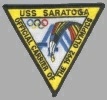 |  | Click here to view more USS SARATOGA Patches. | ||
History of USS SARATOGA:
USS SARATOGA was laid down on 16 December 1952 by the New York Naval Shipyard, New York City, N.Y.; launched on 8 October 1955; sponsored by Mrs. Charles S. Thomas; and commissioned on 14 April 1956, Capt. R. J. Stroh in command.
For the next several months, SARATOGA conducted various engineering, flight, steering, structural, and gunnery tests. On 18 August 1956, she sailed for Guantanamo and her shakedown cruise. On 19 December, she reentered the New York Naval Shipyard and remained there until 28 February 1957. Upon completion of yard work, she got underway on a refresher training cruise to the Caribbean before entering her home port, Mayport, Fla.
On 6 June, President Dwight D. Eisenhower and members of his cabinet boarded SARATOGA to observe operations on board the giant carrier. For two days, she and eighteen other ships demonstrated air operations, antisubmarine warfare, guided missile operations, and the Navy's latest bombing and strafing techniques. Highlighting the President's visit was the nonstop flight of two F8U Crusaders, spanning the nation in three hours and twenty-eight minutes, from USS BON HOMME RICHARD (CVA 31) on the west coast to the flight deck of the SARATOGA in the Atlantic.
The carrier departed Mayport on 3 September 1957 for her maiden transatlantic voyage. SARATOGA sailed into the Norwegian Sea and participated in Operation Strikeback, joint naval maneuvers of the North Atlantic Treaty Organization countries . She returned briefly to Mayport before entering the Norfolk Naval Shipyard for repairs.
On 1 February 1958, SARATOGA departed Mayport for the Mediterranean and her first deployment with the Sixth Fleet. On 15 July 1958, while aircraft from SARATOGA and USS ESSEX (CV 9) flew cover from long range, amphibious units landed 1,800 Marines on the beach near Beirut, Lebanon, to support the Lebanese government and to protect the lives of U.S. citizens. The situation was stabilized within a few days, without untoward incident.
During her August 1959 deployment to the Mediterranean, Attack Squadron 34, flying A-4D Skyhawks and part of SARATOGA's air wing, was the first squadron deployed to the Sixth Fleet equipped with Bullpup missiles.
While deployed with the Sixth Fleet on 23 January 1961, a serious fire broke out in SARATOGA's number two machinery space which took seven lives. The fire, believed caused by a ruptured fuel oil line, was brought under control by the crew, and the ship proceeded to Athens where a survey of the damage could be made.
On 2 January 1968, SARATOGA sailed for Philadelphia and an overhaul and modernization program which was to last 11 months. On 31 January, she departed Philadelphia for Guantanamo Bay, Cuba, via Hampton Roads and Mayport, for extensive refresher training of the crew and air wing.
On 17 May 1968, Armed Forces Day, she was the host ship for President Richard M. Nixon during the firepower demonstration conducted by Carrier Air Wing Three in the Virginia Capes area. On 9 July, she departed Mayport for her ninth Mediterranean deployment. Underway, a Soviet surface force and a "November"-class submarine passed in close proximity, en route to Cuba.
Off the Azores on 17 July 1968, SARATOGA was shadowed by Kipelovo-based Soviet aircraft. They were intercepted, photographed, and escorted while in the vicinity of the carrier. She operated with Task Group 60.2 of the Sixth Fleet in the eastern Mediterranean during September in a "show of force" in response to the large build-up of Soviet surface units there, the hijacking of a Trans World Airlines plane to Syria and the political coup in Libya. Numerous surveillance and reconnaissance flights were conducted by Carrier Wing Three aircraft against Soviet surface units, including the carrier MOSKVA, operating southeast of Crete. SARATOGA operated in this area again in October because of the crisis in Lebanon. She returned to Mayport and the Florida coast on 22 January 1969.
On 24 June 1969, the first operational "hands off" arrested landing using the AN/SPN-42, Automatic Carrier Landing System (ACLS), on a carrier was performed by Lt. Dean Smith and Lt.j.g. James Sherlock of Fighter Squadron 103 when their F-4 Phantom landed aboard SARATOGA.
On 11 June 1970 SARATOGA sailed again for duty with the Sixth Fleet.
On 28 September 1970, President Richard M. Nixon and his party arrived on board. That night, word was received that Gamal Abdul Nasser, President of the United Arab Republic had died; an event that might plunge the entire Middle East into a crisis. The intelligence and communications personnel of SARATOGA were required to supply the President, Joint Chiefs of Staff, and the Secretaries of State and Defense with the essential intelligence information to keep them abreast of the deteriorating situation. The Presidential party departed the ship the next evening, and SARATOGA continued on patrol in the eastern Mediterranean until she sailed for the United States on 2 November.
From her arrival at Mayport until 10 March 1971, she was in a "cold iron" status. She then operated off the Florida coast until 7 June when she departed for her eleventh deployment with the Sixth Fleet, via Scotland and the North Sea where she participated in Exercise Magic Sword II. She returned to Mayport on 31 October for a period of restricted availability and local operations.
On 11 April 1972, SARATOGA sailed from Mayport en route to Subic Bay, P.I., and her first deployment to the western Pacific. She arrived in Subic Bay on 8 May and departed for Vietnam the following week, arriving at "Yankee Station" on 18 May for her first period on the line. Before year's end, she was on station in the Tonkin Gulf a total of seven times: 18 May to 21 June; 1 to 16 July; 28 July to 22 August; 2 to 19 September, 29 September to 21 October; 5 November to 8 December; and 18 to 31 December.
During the first period, SARATOGA lost four aircraft and three pilots. On the plus side, on 21 June 1972, two of her F-4 Phantoms from VF-31 attacked three MiG 21s over North Vietnam. Dodging four surface to air missiles, one of the F-4s, piloted by Cmdr. Samuel C. Flynn Jr., with radar intercept officer Lt. William H. John, shot down one of the MiG aircraft. This Phantom, Bureau number 157307, was later transferred to the Smithsonian's National Air and Space Museum. The aircraft was transferred upon its arrival at Dulles International Airport on 29 November 1988.
SARATOGA's planes attacked targets ranging from enemy troop concentrations in the lower panhandle to petroleum storage areas northeast of Hanoi. On her second line period, she lost an F-4 to enemy fire northeast of Hanoi with the pilot and radar intercept officer missing in action. During this period, her aircraft flew 708 missions against the enemy.
On 6 August 1972, Lt. Jim Lloyd, flying an A-7 on a bombing mission near Vinh, had his plane shot out from under him by a SAM. He ejected into enemy territory at night. In a daring rescue by helicopters supported by CVW-3 aircraft the following day, he was lifted from the midst of enemy soldiers and returned to SARATOGA. It was the deepest penetration by U.S. helicopters into enemy territory since 1968. On 10 August 1972, one of the ship's CAP jet fighters splashed a MiG at night using Sparrow missiles.
During the period 2 to 19 September, SARATOGA aircraft flew over 800 combat strike missions against targets in North Vietnam. On 20 October, her aircraft flew 83 close air support sorties in six hours in support of a force of 250 Territorials beleaguered by the North Vietnamese 48th Regiment. Air support saved the small force, enabled ARVN troops to advance, and killed 102 North Vietnamese soldiers. During her last period on station, SARATOGA's aircraft battered targets in the heart of North Vietnam for over a week.
SARATOGA departed "Yankee Station" for Subic Bay on 7 January 1973. From there she sailed for the United States, via Singapore and arrived at Mayport on 13 February 1973.
On 21 January 1975, SARATOGA, on a Mediterranean deployment, was released from a response alert for possible evacuation of U.S. citizens from Cyprus during a period of strife on that island.
In March of 1980, SARATOGA and embarked airwing CVW-17 departed on their 16th Mediterranean deployment. Highlights of the deployment included major exercises with the USS FORRESTAL (CV 59) battle group, and visits by the Chief of Naval Operations, Adm. Thomas B. Hayward, and Master Chief Petty Officer of the Navy Thomas C. Crow. Then-commanding officer, Capt. James H. Flatley III, made naval aviation history on 21 June 1980 when he completed his 1,500th carrier arrested landing. To make the event special, Midshipman James H. Flatley IV, the Captain's son, rode in the back seat.
On 28 September 1980, only one month after her return from deployment, SARATOGA departed Mayport and headed north to the Philadelphia Naval Shipyard where she underwent the most extensive industrial overhaul ever performed on any Navy ship. SARATOGA was the first ship to go through the Service Life Extension Program (SLEP) overhaul that would last 28 months. She conducted sea trials on 16 October 1982, and left Philadelphia with much fanfare on 2 February 1983 with her new nickname - "Super Sara."
SARATOGA departed the Mayport Basin yet again for her 17th Mediterranean deployment on 2 April 1984.
SARATOGA's 18th deployment was anything but ordinary. After departing Mayport in August 1985, SARATOGA steamed toward the Mediterranean for what was scheduled to be a routine deployment. But on 10 October, SARATOGA was called into action.
Arab terrorists had found and struck an Italian luxury liner, ACHILLE LAURO. The ship had just departed Alexandria, Egypt, on a pleasure cruise of the Mediterranean. A few hours later, terrorists from the Palestinian Liberation Front hijacked the ship. After tense negotiations and the killing of an American tourist, the hijackers traveled in a battered tugboat to the city of Port Said, Egypt, after ACHILLE LAURO anchored just off the coast. Egyptian authorities made hasty arrangements for the terrorists to depart the country. They boarded an Egypt Air 737 jet at the Al Maza Air Base, northeast of Cairo.
On orders from President Ronald Reagan, seven F-14 Tomcats from the VF-74 "Bedevilers" and VF-103 "Sluggers" were launched from SARATOGA. Supporting the Tomcats continuously were VA-85 KA-6D air tankers and VAW-125 E-2C Hawkeye aircraft. Off the coast of Crete, the F-14s, without the use of running lights, eased up beside and behind the airliner. On command, the Tomcats turned on their lights and dipped their wings - an international signal for a forced landing. The E-2C Hawkeye radioed the airliner to follow the F-14s. Realizing they were in a "no-win" situation, the hijackers allowed the pilot to follow the Tomcats to Naval Air Station, Sigonella, Italy.
One hour and 15 minutes later, the jet landed and the hijackers were taken into custody. Seven hours after the fighter jets were scrambled, all SARATOGA aircraft returned home without a shot fired.
On 23 March 1986, while operating off coast of Libya, aircraft from the SARATOGA, USS CORAL SEA (CV 43) and USS AMERICA (CV 66) crossed what Libyan strongman Mohammar Khadafi had called the "Line of Death." The very next day at noon, three U.S. Navy warships crossed the same 32° 30' navigational line.
Two hours later, Libyan forces fired SA-5 surface-to-air missiles from the coastal town of Surt. The missiles missed their F-14 Tomcat targets and fell harmlessly into the water. Later that afternoon, U.S. aircraft turned back two Libyan MiG-25 fighter planes over the disputed Gulf of Sidra. Soon after, aircraft from the three carriers fought back in defense.
A heavily-armed A-6E Intruder fired Rockeye cluster bombs and a Harpoon anti-ship cruise missile at a Libyan missile patrol boat operating on the "Line of Death." Later that night, two A-7E Corsair II jets attacked a key radar installation at Surt. At the conclusion, three Libyan patrol boats and a radar site were destroyed by Navy aircraft.
Following SARATOGA's 19th Mediterranean deployment in June 1987, she was overhauled once again at the Norfolk Naval Shipyard at a cost of $280 million.
SARATOGA departed Mayport for her 20th deployment on 7 August 1990, just days after Iraqi tanks invaded Kuwait. SARATOGA and Carrier Air Wing 17 rapidly crossed the Atlantic, the Mediterranean and transited the Suez Canal on 22 August to take up station in the Red Sea.
In the early morning hours of 17 January 1991, Operation Desert Shield became Operation Desert Storm. Aircraft from SARATOGA flew against Iraq in the first step to knock out the Arab nation's military power and drive it from conquered Kuwait. CVW-17 aircraft dropped more than four million pounds of ordnance on enemy targets.
However, on 17 January, Lt. Cmdr. Michael Scott Speicher, flying an F/A-18C Hornet of VFA-81 aboard SARATOGA, was shot down by an Iraqi surface-to-air missile, the first U.S. casualty of the Gulf War. He was placed in an MIA status the next day. On May 22, 1991, following a Secretary of the Navy status review board that found "no credible evidence" to suggest he had survived the shootdown, his status was changed to Killed in Action/Body Not Recovered (KIA/BNR). On 11 January 2001, Secretary of the Navy Richard Danzig changed the status of Cmdr. Michael Scott Speicher from KIA/BNR to Missing in Action (MIA), based on new information.
On 21 January 1991, an F-14 Tomcat of VF-103 aboard SARATOGA, was shot down by a surface-to-air missile. Pilot Lt. Devon Jones and Radar Intercept Officer Lt. Lawrence Slade were reported missing. Lt. Jones was recovered the following day, but Lt. Slade was captured as a prisoner of war.
Flying on 30 January, all 18 F/A-18s aboard SARATOGA delivered 100,000 pounds of MK-83 1,000-lb. bombs on Iraqi position in occupied Kuwait. This was the largest amount of bomb tonnage carried on a single mission.
SARATOGA departed the Gulf 11 March 1991. After seven months and 21 days, 11,700 arrested landings, 12,700 sorties flown, 36,382 miles traveled and a record six Suez Canal transits, SARATOGA returned home 28 March to a hero's welcome.
SARATOGA's 21st Mediterranean deployment, which began 6 May 1992, was much more than normal operations in the Med. Her six month deployment found her in the Adriatic Sea, providing close-air support for humanitarian relief flights flying into the war-torn former Yugoslavia. Thousands of support missions were flown, but more importantly, not one single piece of ordnance was dropped - proving that U.S. military presence is a powerful deterrent. On 27 August, aircraft from SARATOGA and USS INDEPENDENCE (CV 62), both in the Arabian Gulf, began enforcing the no-fly zone south of the 32nd parallel in Iraq under Operation Southern Watch. Any Iraqi warplanes violating that airspace would be shot down. This was to prevent the Iraqis from attacking Shiite Moslem ethnic groups in the marshes of southern Iraq. From the Gulf, SARATOGA returned to the Mediterranean and was there relieved on 7 October by USS JOHN F. KENNEDY (CV 67).
"Super Sara," along with Carrier Air Wing 17 (CVW-17), began her final deployment 12 January 1994, entering the Mediterranean Sea January 26 after a choppy Atlantic Ocean crossing. Ship and air wing spent that day, east of Gibraltar, receiving "turnover briefs" from SARATOGA's predecessor in the Mediterranean, USS AMERICA (CV 66). As AMERICA ended her deployment, setting sail for home, SARATOGA headed east for the area the crew would come to call "Groundhog Station" in the Adriatic Sea.
Entering the Adriatic February 1, SARATOGA and CVW-17 launched the first of thousands of sorties in support of U.N. and NATO operations Deny Flight and Provide Promise over Bosnia-Herzegovina. Actress Halle Berry, star of films Boomerang, Jungle Fever and The Last Boy Scout, spent an afternoon with Sailors on station in the Adriatic Sea aboard SARATOGA 3 February. Then, after 44 consecutive days at sea, SARATOGA visited the northern Italian city of Trieste for some eagerly awaited liberty.
The ship departed Trieste 28 February 1994, taking up station in the southern Adriatic once again, in response to the U.S. Air Force downing of four Bosnian Serb Super Galeb attack aircraft The four jets had been flying in defiance of the U.N.-NATO "No Fly Zone" over the former war-torn Yugoslavia.
SARATOGA remained on station until 10 March. Departing for the eastern Mediterranean, ship and air wing participated in exercises over land and sea with U.S. allies in that part of the world. Finishing up on 18 March, SARATOGA returned to Trieste for another well-deserved period of recreation, then to the Greek island of Crete for bombing exercises at the Avgo-Nisi bombing range.
Completing the exercises, the SARATOGA/CVW17 team returned to the Adriatic for five more days of flying in support of Deny Flight and Provide Promise. Departing "Groundhog Station" 7 April , SARATOGA transited the Straits of Messina between Sicily and the toe of the "boot" of southern Italy, for a port call at Naples, Italy, before returning to the Adriatic for the fourth time on 17 April.
SARATOGA anchored off the resort city of Palma de Mallorca, Spain, 3 May 1994, for one week of the most eagerly-awaited port calls of the deployment. After a week of liberty on the sun-drenched Spanish island, it was back to business as SARATOGA participated in the Mediterranean exercise Dynamic Impact. This exercise featured joint maneuvers with several NATO-member navies, as well as the U.S. Air Force.
Finishing six days of liberty in Valencia, Spain, SARATOGA participated in Iles D'Or, or "Islands of Gold," - an exercise with the French Navy, lasting until 9 June. SARATOGA, the Navy's oldest active duty carrier, then headed for the rendezvous point with her relief, the nuclear powered aircraft carrier USS GEORGE WASHINGTON (CVN 73), the Navy's newest carrier at the time.
SARATOGA arrived pierside at Naval Station, Mayport, Fla., early in the morning of 24 June 1994. With the end of the 164-day deployment - the last in the carrier's 38-year career - SARATOGA's crew prepared to deactivate the ship, offloading material and closing out each of the ship's more than 3,500 spaces.
SARATOGA was decommissioned at the Naval Station, Mayport, Fla., 20 August 1994, and was stricken from the Navy List the same day. Chief of Naval Operations Adm. Mike Boorda was the keynote speaker at the decommissioning.
SARATOGA was towed out of the Naval Station Mayport basin on 22 May 1995 and taken to Philadelphia to become part of the Navy's inactive fleet. In 1998, upon the deactivation of the Philadelphia Navy Yard, she was towed to Newport, R.I., departing 3 August and arriving at the Naval Education and Training Center on 7 August 1998. She was first placed on donation hold, then her status was changed to disposal as an experimental ship. SARATOGA was returned to donation hold on 1 January 2000. She remained at the Naval Station, Newport, R.I., for the following years. In May 2014, the Navy announced that ESCO Marine of Brownsville, Tx, would scrap the SARATOGA for one cent. The carrier left Newport under tow on August 21, 2014, and arrived at Brownsville on September 15, 2014.
SARATOGA received one battle star for service in the Vietnamese conflict.
Accidents aboard USS SARATOGA:
| Date | Where | Events |
|---|---|---|
| October 14, 1958 | Jacksonville, Fla. | An explosion floods the engineering room of SARATOGA at Jacksonville, Florida. |
| May 25, 1960 | off North Carolina | USS SARATOGA collided with the German freighter BERND LEONHARDT. The angled deck of the carrier got into the bridge of the freighter. The collision took place at night and the weather was well. Because of the damage SARATOGA had to steam back to Norfolk, Va. The freighter was heavily damaged. |
| May 30, 1960 | Norfolk Naval Shipyard, Va. | SARATOGA suffers an oil-fed flash fire at the Norfolk Naval Shipyard where she had docked after the May 25 collision. The fire scorches the carrier's amidships hull. |
| January 23, 1961 | 100 nautical miles off Piraeus, Greece | SARATOGA suffers a fire caused by a ruptured oil line, killing 7, injuring 23. |
| August 15, 1963 | Mediterranean | An F3H Demon aircraft lands on the fouled deck of USS SARATOGA killing two and seriously injuring nine. Fifteen aircraft sustain damage. |
| August 15, 1971 | Athens, Greece | USS SARATOGA suffers flooding in an engine room while anchored off Athens, Greece. |
| August 20, 1971 | eastern Mediterranean | SARATOGA suffers another engine room flood shortly after leaving Athens, Greece, where repair from a similar flood of August 15 just was completed. |
| October, 1972 | Singapore | During a port visit to Singapore there was a fire in the boiler-room. Three crewmen were killed, 12 were injured and the carrier was lightly damaged. |
| September 22, 1973 | Norfolk, Va. | SARATOGA experiences a fire on the third deck, between the flight deck and the hangar bay, which takes nine hours to extinguish while the ship is in drydock at Norfolk, Va. |
| December 13, 1974 | Tyrrhenian Sea | A jet blast deflector is inadvertently raised into the turning propeller of a plane while the USS SARATOGA is involved in exercise "National Week XVII" in the Tyrrhenian Sea, injuring five crewmen and damaging five planes. |
| December 15, 1975 | off the Florida coast | USS SARATOGA and the USS MISSISSINEWA (AO 144) are in a minor collision during an underway replenishment off the Florida coast. |
| August 23, 1977 | en route to the Straits of Messina | An aerosol can explodes in the #2 incinerator of the USS SARATOGA causing a fire which threatens the aircraft of Hangar Bay #2. According to the Navy, "the fast and professional reaction of the crew and the decision to call away General Quarters can be directly credited for the successful handling of the potential disaster." |
| October 6, 1977 | Straits of Messina | USS SARATOGA collides with the Austrian container ship VILLE D'ORIENT with no injuries and minor damage reported. |
| November 21, 1978 | 50 miles south of Crete, Greece | SARATOGA and USNS WACCAMAW (T-AO 109) collide during a refueling operation suffering minor damage and no injuries. |
| October 20, 1980 | Philadelphia Naval Shipyard, PA | USS SARATOGA suffers five minor fires from October 20 to 26 while undergoing a major overhaul at the Philadelphia Naval Shipyard. The Navy investigates the possibility of arson. |
| June 17, 1982 | Philadelphia Naval Shipyard, PA | Ten persons are injured when a 1,200-lb steam valve ruptures aboard USS SARATOGA, which is undergoing a SLEP overhaul in Philadelphia Naval Shipyard. |
| August 18, 1989 | 70 miles off Jacksonville, Fla. | Five sailors are tossed overboard while being lowered from the USS SARATOGA during a man-overboard drill. No injuries are reported. |
| 1992 | Mediterranean | USS SARATOGA accidentally launched two Sea Sparrow missiles of which one hit the Turkish destroyer MAUVENET killing 5 Turkish sailors including the destroyer's commanding officer. |
| April 28, 1994 | Adriatic Sea | A SARATOGA-based |
USS SARATOGA Image Gallery:
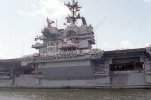 | 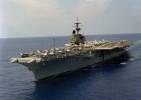 | 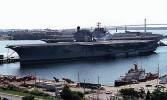 |  | 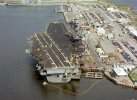 |
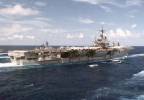 | 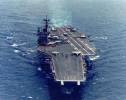 | 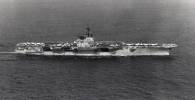 | 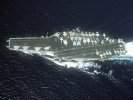 | |
 | 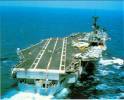 | 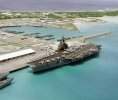 | 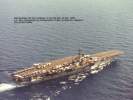 | 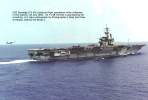 |
The photos below were taken by me and show the SARATOGA laid up at Naval Station Newport, RI., on August 21, 2010.
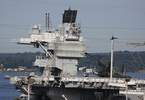 | 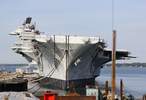 | 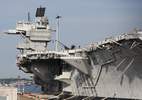 | 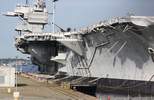 | 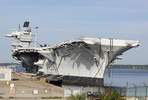 |
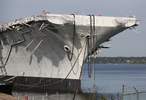 | 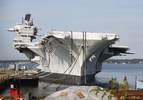 | 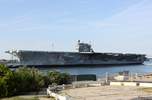 | 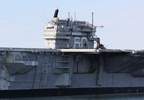 | 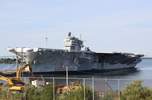 |
The photo below was taken by Michael Jenning and shows the SARATOGA at Brownsville, Tx., on October 28, 2014, shortly before being scrapped.
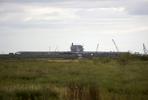 |
 Back to Carriers list.
Back to Carriers list.  Back to ships list.
Back to ships list.  Back to selection page.
Back to selection page.  Back to 1st page.
Back to 1st page.